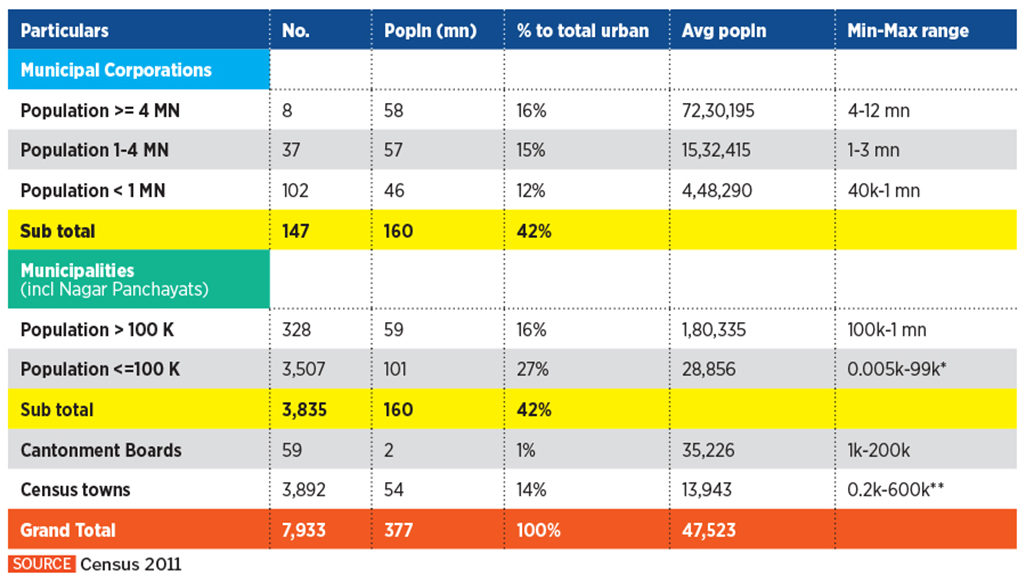UPDATING URBAN DEFINITIONS COULD OPTIMIZE OUR RESOURCE ALLOCATION
Relevance: GS 2 – Parliament and State legislatures—structure, functioning, conduct of business, powers & privileges and issues arising out of these.
Why in the News?
- Despite the 73rd and 74th Constitutional amendments, India’s local governments remain weak.
- They function more as extensions of state governments rather than independent tiers of government.
- To fulfill the promise of Viksit Bharat by 2047, a radical shift in perspective on local governments is essential.
- Most economies that have achieved developed status, including China, have benefited from strong local governments driving economic growth in cities.
Allocation of Resources
- Only 4% of the divisible pool is allocated to local governments by Finance Commissions.
- Cities receive a mere 1.4% of this allocation.
- India’s investment in cities averaged 6% of GDP during 2011-2018, significantly lower than China’s 2.8% of GDP during 2000-2014.
Empowerment of Cities
- To facilitate rapid development, cities must be empowered.
- Resources should be transferred in alignment with the 18 constitutionally identified functions outlined in the 74th Amendment of the Constitution.
Challenges in Defining Cities
- India faces the challenge of defining what constitutes a city due to the diversity of municipal acts across states and Union territories.
- Five different criteria are currently used, including population, density, employment, revenue generation, and guidelines under Article 243Q of the 74th Amendment.
- These criteria lack modern parameters such as data on mobility, labour markets, density, built-up forms, and night-time data.
Outdated Census Data
- Census 2011, although outdated, identified “census towns” governed as village panchayats but possessing urban characteristics based on specific criteria.
- There were also 4,041 statutory towns governed as municipal areas identified during Census 2011.
- Additionally, 53 urban agglomerations (UAs) were identified, encompassing larger metropolitan areas, including smaller urban local bodies (ULBs) and panchayati raj institutions (PRIs).
Need for Coherent Urbanization Approach
- India requires a more coherent approach to urbanization, considering the complexities of urban and rural areas within urban agglomerations.
- The central government should take a leadership role in developing a comprehensive framework for urbanization.
Reference Point
- The Odisha government has introduced a rural-urban transition policy to prepare urbanizing panchayats for urban governance
- This policy could serve as a valuable reference for other regions grappling with similar challenges in defining and managing urban areas.
Recommendations for Urban Allocations
- Utilization of Advanced Geospatial Tools
- The 16th Finance Commission (FC) should incorporate advanced geospatial tools and alternate data to identify cities for resource allocations.
- Relying solely on 2011 census data would be inadequate given the rapid pace of urbanization.
- Tools such as population projections, night-time luminosity, consumption expenditure, and vehicle and property registrations can provide more current and accurate data.
- Differentiated Treatment for Metropolitan Areas
- Metropolitan areas should continue to receive differentiated treatment, with outcome-based funding aligned with ambitious economic growth, environmental sustainability, and equity goals.
- Allocation decisions should cover the entire metropolitan area, including census towns, which should be considered urban for resource allocation purposes.
- Learning from the UK’s “city deals” model could provide valuable insights.
- Tailored Resource Allocations for Different City Types:
- The FC should recognize the diverse needs and capabilities of different types of cities and tailor resource allocations accordingly.
- Larger metropolitan areas can leverage their economic strength to finance development, while mid-sized cities may require support to enhance their economic growth capabilities.
- Smaller cities need long-term unconditional support to develop robust institutions.
- A one-size-fits-all approach will not work.
- Evaluation of Districts as Units of Resource Allocation:
- The FC should evaluate the role and relevance of districts as units of resource allocation, considering the spatial contiguity of Indian cities.
- Districts, being well-understood administrative units, can facilitate integrated and coordinated economic and ecological development.
- Incorporating spatial contiguity in resource allocation can optimize efficiency.
- Local-Government-Centric Approach for Resource Allocation:
- Shift towards a simpler, local-government-centric approach (rather than state-centric) approach, for ascertaining individual Urban Local Body (ULB) shares across India.
- Determine ULB shares directly based on their individual share in the total ULB population, excluding metropolitan areas.
The 16th FC has the opportunity to redefine urban allocations using modern tools and principles, thereby accelerating Viksit Bharat’s realization, especially for smaller cities, by promoting planned urbanization.
Mains Question
Discuss the challenges in defining cities in India and propose recommendations for effective urban resource allocation and administrative dynamics. (150 words)




